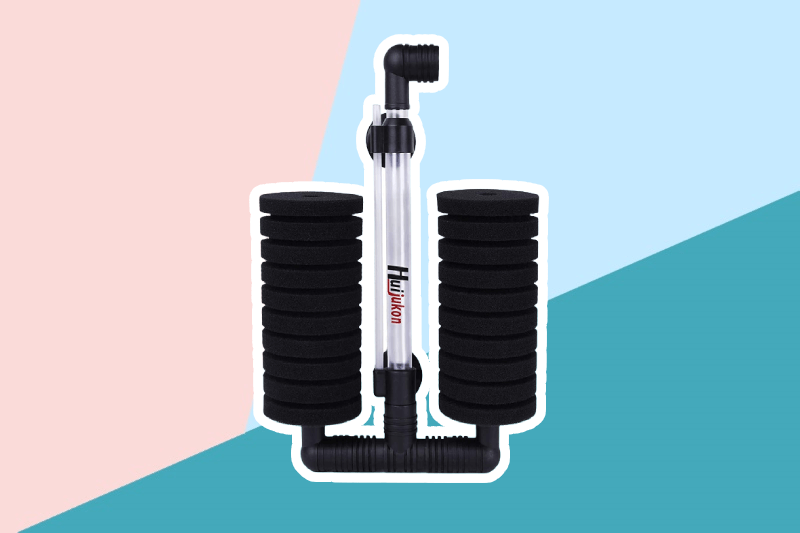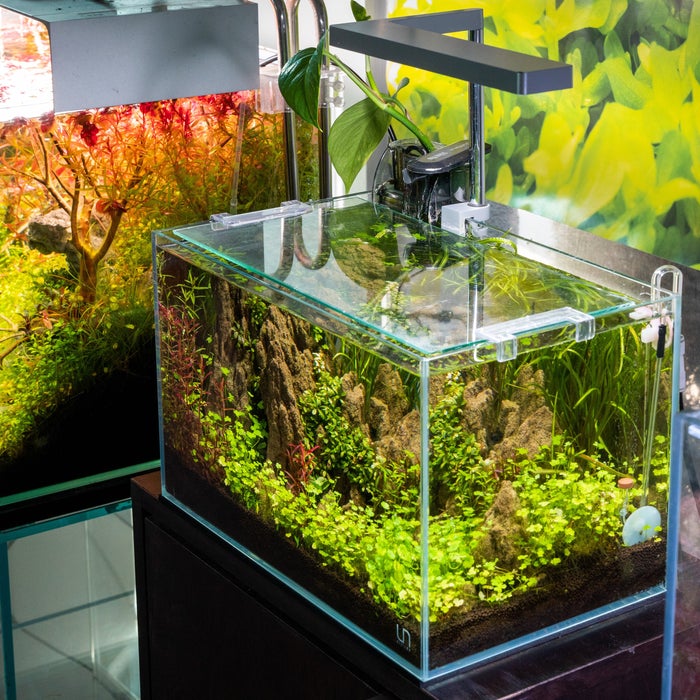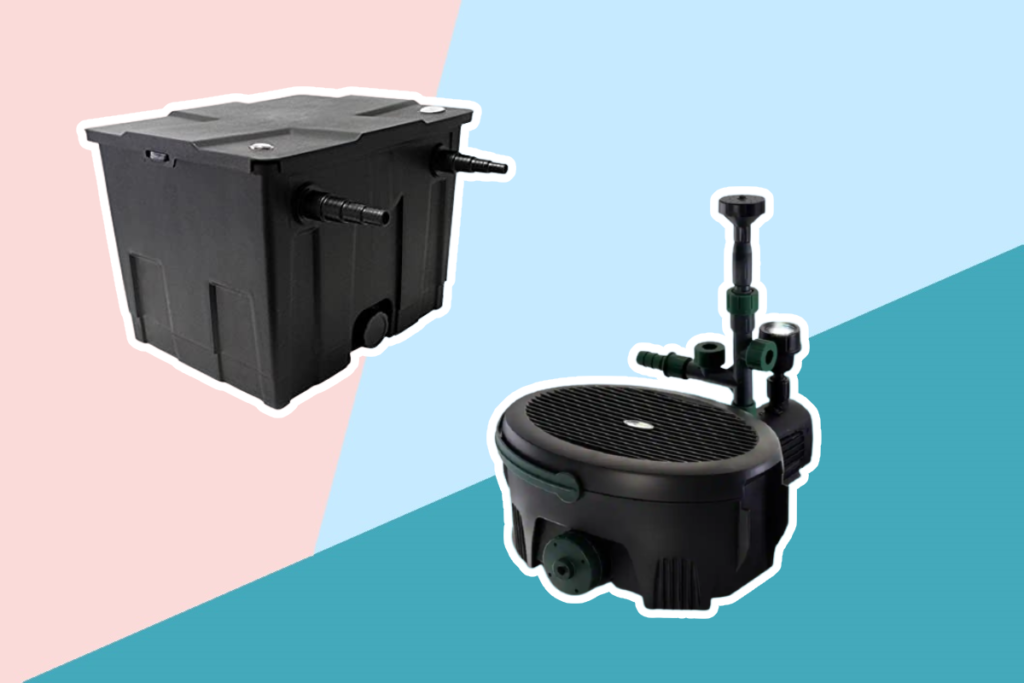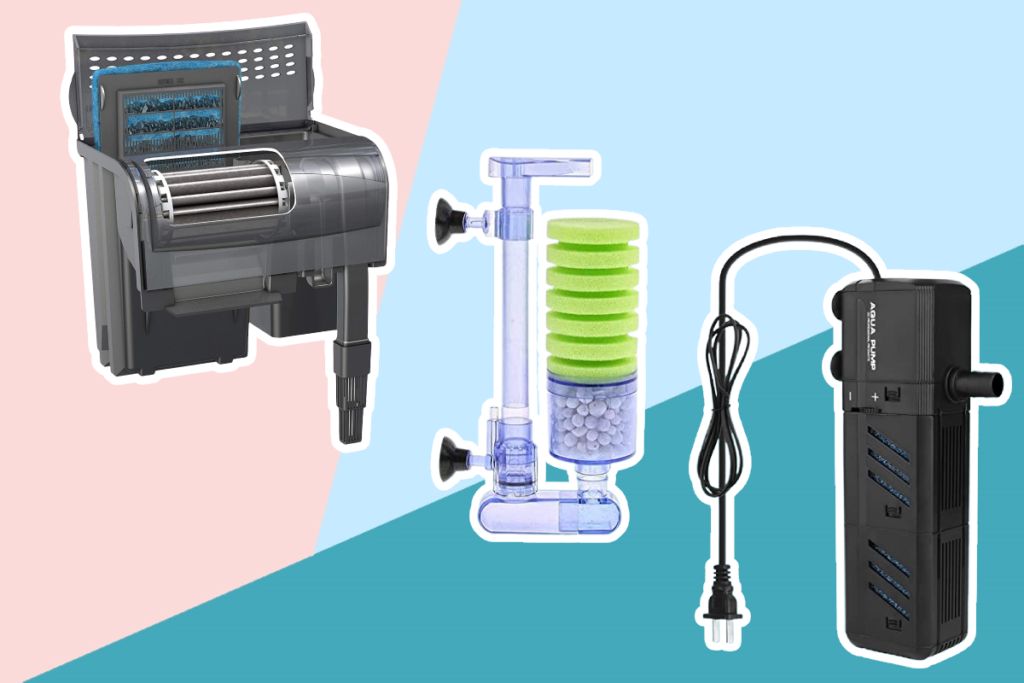

If your fish prefer slow-moving water, a canister filter is excellent for your aquarium since it reduces splashing and currents as it reintroduces the water to the fish tank. That said, finding the best canister filter from the options in the market is no cakewalk.
However, we reviewed and rounded up the best gadgets for the job according to key features like flow rate, aquarium capacity, filtration stages available, and more. The aquarium capacity and flow rate determine the right size aquarium for each filter and how fast it cleans up the water. As for the filtration stages available, they dictate the types of impurities removed from the fish tank water. For the full list of selections, keep reading.
More features: auto start, 12 hours air auto-evacuation, rubber feet, 3.7-gal filtration volume, 30 W power output
The Fluval FX4 is an impressive machine with a 30W power output that handles large aquariums easily. Additionally, it incorporates some automation features such as auto start and air auto-evacuation. Next, it’s designed to include mechanical, biological, and chemical filter media with up to five filtration stages available for cleaner water. Furthermore, the 700 gph flow rate means it can cycle through all the water in your 250 gal aquarium more than twice in an hour.
This is one of the best aquarium canister filters for people with large fish tanks of up to 250 gallons. It offers all the qualities needed for healthy environment in an aquarium.
More features: self-priming, non-slip pads, saltwater compatible, fully rotatable valve taps
Another option for those with extra-large aquariums is the Penn-Plax Cascade Max Flow. Ideally, it should be used with 205-gallon fish tanks or smaller. However, given its capabilities, this model is usable for aquariums with a capacity of up to 273 gallons. Notably, the design comes with four baskets to position your various filter media. Additionally, with the inclusion of a self-priming feature, it will be tough to damage the motor on the device.
The Penn-Plax Cascade Max Flow is one of the best canister filters for a turtle tank since the flow rate is adequate for clearing out their excrement. It offers fastest cleaning for 200-gallon tanks.
More features: 15 W power consumption, 11 lbs weight, 5.6 ft max head height
As for the OASE Indoor Aquatics Biomaster, calling it one of the best canister filters for 55-gallon aquariums wouldn’t be a stretch. However, its maximum capacity stands at 66 gallons. Like the Penn-Plax Cascade Max Flow, buyers get four filtration stages, including a pre-filter module that comes off separately for easier cleaning. Additionally, it’s designed to float the filter media, which increases the surface area for the bacteria responsible for biological filtration to multiply.
The OASE Indoor Aquatics Biomaster is for users who want both a canister filter and a water heater in one device. It is easy to set up, and change parts.
More features: quick-release valve block, quick prime button, 60 in max head height
Another model that’s just as capable in saltwater as in freshwater is the 100-gallon capacity Marineland Magniflow 360. In terms of filtration stages, this device only offers three that you can access by just lifting the lid. Additionally, it comes fitted with a quick-release valve block for maintenance. Once engaged, this component wastes no time shutting down water flow or disengaging from the motor housing, making maintenance hassle-free.
The Marineland Magniflow 360 is an excellent selection for aquarium owners who want an easy time with maintenance and priming.
More features: aquastop valve, quick primer, 68.8 in max head height, 16 W energy consumption
Next is the Fluval 307, which is from the same manufacturer as the editor’s choice. With 16 W energy consumption, the device is relatively economical. However, that’s not all. It comes with a quick primer feature that helps eliminate air from your pump. Additionally, there are four filtration stages with the new Bio-Foam Max sponges. This results in better biological filtration compared to models like the Fluval 306 from the previous generation.
The Fluval 307 has significant improvements over the 306, including the biological filtration mentioned above, the smaller design, and even performance upgrades that make the machine quieter.
More features: built-in spray-bar, four media trays, built-in UV sterilizer, drip-free shut-off
The CNZ HW-704B is a fantastic all-rounder for anyone looking for the full package. The device comes with a 525 gph flow rate and should work for most 150 gallon aquariums or smaller. Additionally, users get filtration trays that they can fill with whichever media they want. What makes this unique is the presence of the UV sterilizer and spray bar. As such, the filter can eliminate more impurities from your aquarium than most others.
This filter differentiates itself from other canister filters by having a UV sterilizer. Consequently, it’s able to remove algae alongside other contaminants in the water.
More features: saltwater compatible, quick disconnect valves, pump locking heads, 36 lbs weight, 49 W power consumption
The Aqueon Quietflow 400 is in a similar capacity range as the CNZ HW-704B with regard to the size of the aquarium. Additionally, both offer four customizable filtration stages. However, for this model, it comes preloaded with the first batch of filter media. Finding replacements for the same is also easy. Next, this device qualifies as one of the best saltwater canister filters available. Lastly, the 49W power consumption isn’t bad for a 155-gallon aquarium capacity filter.
This external fish tank filter is for users who want something saltwater compatible that’s easy to maintain.
More features: 18 W power consumption, 4.6 ft max head height, self-priming pump, adjustable spray bar
With the Polar 525GPH’s flexible media trays, users get to decide the type of media they want for their aquariums. The power consumption for this canister filter is only 18W, which is slightly above some of the competition but still reasonably economical. Additionally, there’s the self-priming pump, which reduces your workload whenever you restart the device. As for the warranty, it only lasts long enough for you to test the machine.
The Polar Aurora Free Media 525GPH is for users with 75-gallon fish tanks or smaller who want economic power consumption in their filters.
More features: for aquatic turtles, 10-7/8 in tubes
As implied by the name, the Zoo Med Turtle Clean 15 is designed for small turtle aquariums. After all, it only works with 15-gallon aquariums or smaller. Despite being designed for turtles, it still contains the necessary biological, mechanical, and chemical filtration to allow your aquarium to thrive. Also notable is the see-through design. The manufacturer builds it like this, so users can quickly figure out when to change the media.
This canister filter is for users with turtles in their small aquariums.
More features: water intake strainer included, 3.5 lbs weight
The filtration media included with the Finnex PX-360 includes ceramic rings, a sponge, and a carbon floss pad. It’s a reasonably compact filter with only a 3.5 lbs weight. That said, it’s capable of holding its own against even a 25-gallon fish tank. It should work just as well for turtles as well. Furthermore, it incorporates a water intake strainer, so the filter media don’t have to do all the work.
This canister filter is for users on a budget who still want something usable for both fish and turtles in the aquarium.
More features: permo-elastic silicone sealing ring, 2 lbs weight, 5 W power consumption
One of the best small canister filters available is this EHEIM Classic 150 model. It’s designed to work with loose filtration media, filter sponges, or a mix of both. That said, the first set of filter media is already provided. The design also incorporates a pump head that only needs 5W of power to function. Furthermore, there’s the Permo-elastic silicon sealing ring that allows for the pump head to be firmly and safely attached to the rest of the device.
This is for users with 10-gallon aquariums or smaller without spending a fortune on an equipment.
More features: 11 W power consumption, 10-7/8 in tubes, adjustable flow control system
The Zoo Med Nano 30 is the second offering on the list from the same manufacturer as the Zoo Med Turtle Clean 15, and as implied by the name, it’s best suited to nano tanks. Anything below a 30-gallon capacity should be fine. Other than that, there is an adjustable flow control system that you can tweak to match your fishes and their needs. Additionally, it only consumes 11W of power.
This canister filter works for users with either saltwater or freshwater nano aquariums.
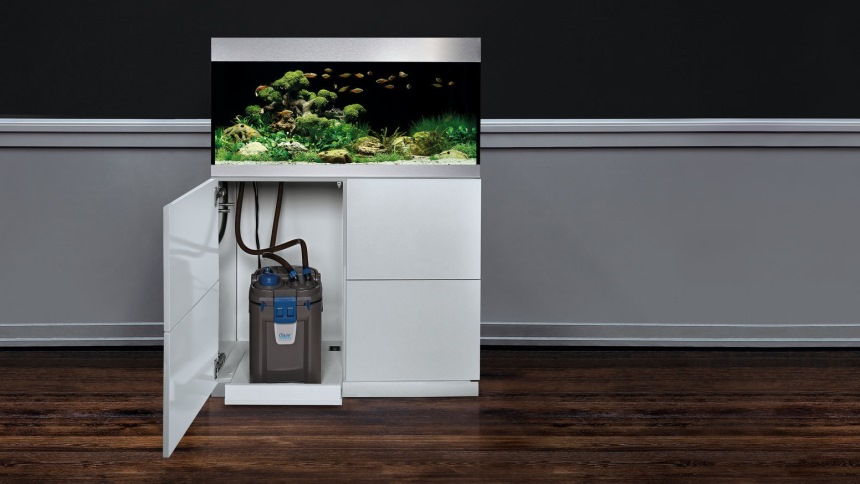
Before getting into the setup process for canister filters or how to pick the best external aquarium filter for your budget, here’s a quick overview of the pros and cons of these devices. One positive is they give control to the users over what types of filter media to use. As such, you can customize yours to match the needs of your aquarium. For instance, if your fish tank water has lots of debris, it makes sense to add a pre-filter and some canister filters give you the option to do that.
Additionally, since the devices are designed to work outside the aquarium, they don’t take up any space in your fish tank, and therefore your fish have more room to roam. Another benefit of the exterior design is the easy access compared to power filters. This makes it easier to open the machine whenever you’re replacing the filter media or carrying out some other form of maintenance.
Next, canister filters are usually fitted with powerful pumps which allow the device to cycle through and clean huge amounts of water. They’re thus an effective tool if your fish or other aquatic pets excrete a lot of waste.
Also, it’s easier to add some extra cleaning accessories such as inline heaters and UV sterilizers with canister filters. In fact, options like the CNZ HW-704B come with built-in UV sterilizers. Lastly, you don’t lose as much water to evaporation when you use external canister filters instead of power filters.
As for the cons, canister filters are often bulky and, depending on the design, can be an eyesore in the area around the fish tank. Consequently, they present a problem to anyone who desires their functionality but dislikes their aesthetics during the installation. Additionally, they’re typically noisier than power filters.
Lastly, depending on the size and capabilities of the device, canister filters can be pretty expensive.
Before setting up a canister filter, you have to be sure it’s the right size and has the correct capabilities for your aquarium size. Often this is indicated by the manufacturer even before you purchase the device.
For instance, if your aquarium can handle 55 gallons of water, ensure you pick a filter with a similar capacity or higher. The OASE Indoor Aquatics Biomaster, with its 66-gallon capacity, would be perfect for a 55-gallon tank. However, be careful not to pick a capacity that’s too high for your tank’s size as it may introduce unfavorable water currents for some fish.
As for installation, your product should come with instructions on how to pull it off. However, sometimes these instructions are hard to understand and may be no help at all, in which case this general guide might be helpful.
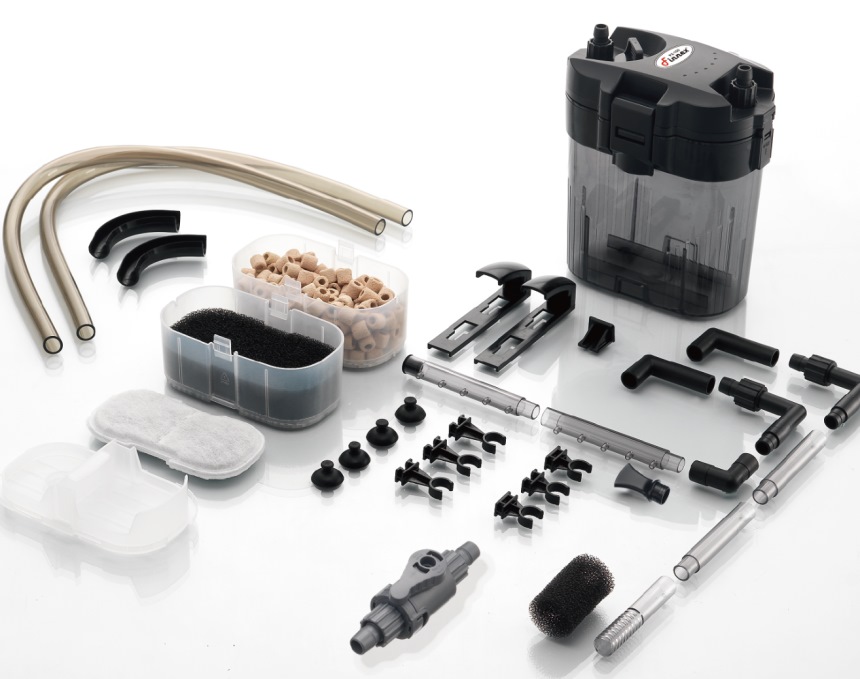
First, check for all components listed in the manual. If any of the pieces are missing, you might not be able to install the device. This includes items like the canister, motor, filter baskets, hoses, connectors, clamps and clips, media if present, and more.
As noted above, some of the components may feature flimsy construction, and it’s best to upgrade them as soon as possible. The hoses, in particular, need to be of top-tier quality, and if you can upgrade them affordably, you should.
Next, you need to set up your aquarium. It should be raised, seeing as canister filters are often placed below the fish tank. That said, some of the best aquarium canister filters can also be attached to the back of the tank. After that, add water to the maximum level in the tank. Remember, this should be conditioned water to ensure it’s safe for the fish.
You also need to prepare the filter. This will typically include some assembly and maybe even opening the device. If the filter media are provided and already installed on the filter baskets, there likely won’t be much to do. However, if the media aren’t installed or supplied with the purchase, you need to get and add them to the setup.
Once you have your media, you’ll have to position the mechanical filter as the first point of contact. As such, if the setup for your canister filter involves water coming in through the bottom and exiting the top, the mechanical media should be at the bottom.
If you have multiple mechanical media, start with the coarse option and end with the finest option. That way, with each subsequent level of filtration, the media gets rid of more and more solid particles.
Biological filtration is the second stage, and thus the biological media should follow the mechanical. Often this includes a sponge filter that doubles as a home for Nitrosomonas and Nitrobacter bacteria.
According to Frontiers Media Trusted Source Ecophysiology and Comparative Genomics of Nitrosomonas mobilis Ms1 Isolated from Autotrophic Nitrifying Granules of Wastewater Treatment Bioreactor Ammonia-oxidizing bacteria (AOB), which oxidize ammonia to nitrite in the first step of nitrification, play an important role in biological wastewater treatment systems. Nitrosomonas mobilis is an important and dominant AOB in various wastewater treatment systems. www.frontiersin.org , Nitrosomonas are ammonia-oxidizing proteobacteria which means they’re crucial in eliminating ammonia excreted by the fish in the tank. Nitrosomonas bacteria are also used in wastewater treatment plants. The Nitrobacter bacteria have a similar function.
The last one or two filter baskets will contain chemical filters, with activated carbon being the most popular option. These will help get rid of chemical contaminants like chloramine.
According to the United States Environmental Protection Agency Trusted Source Basic Information about Chloramines and Drinking Water Disinfection Chloramines are disinfectants used to treat drinking water. Chloramines are most commonly formed when ammonia is added to chlorine to treat drinking water. Chloramines provide longer-lasting disinfection as the water moves through pipes to consumers. www.epa.gov , chloramines, like chlorine, are used to treat drinking water. However, they are harmful to fish and need to be removed from your aquarium.
Follow up by connecting the pipes as per the installation instructions. You may get connectors with the purchase to help fasten the lines to the intakes and outlets on the filter. After that, you’ll position the pipes in the water and use clamps and hose clips to hold them in place. Ideally, the pipes should run straight from the filter to the fish tank with no loops or kinks.
The final stage before leaving the machine to run is to prime it. Some options like the Penn-Plax Cascade Max Flow offer self-priming, making this process as simple as pressing a button. Others will require manual priming to eliminate air by replacing it with water. After that, check the connections one last time before turning on the filter.
As for the selection criteria for the best canister filter for freshwater or saltwater aquariums, it’s highlighted below.
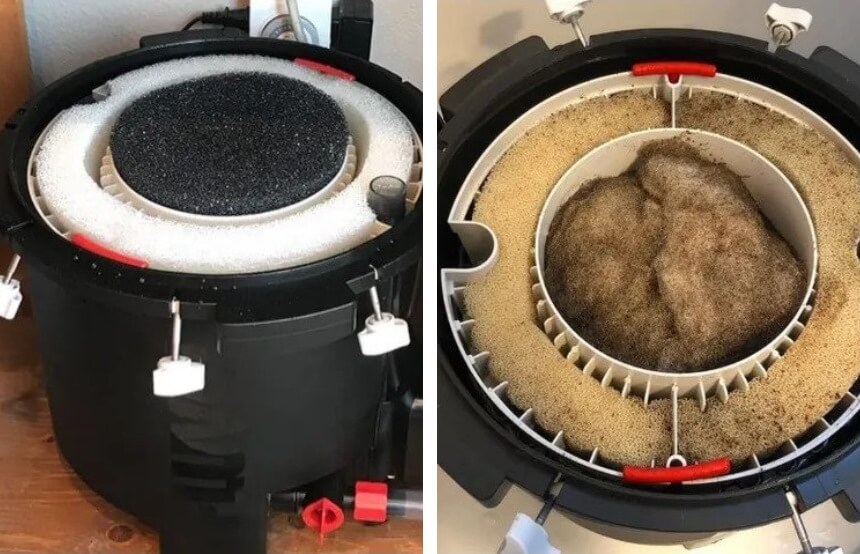
First, check the filtration system. Does it support all the filter media you need? Ideally, each canister filter should have at least three stages of filtration. The mechanical, biological, and chemical.
Some, like the Fluval FX4, have even more filtration stages in their design. This allows the inclusion of a pre-filter and maybe an extra chemical filter. The result is cleaner water. However, just the three basic options should be enough for most aquariums.
Next, check the flow rate and capacity. You don’t want to buy a 150-gallon device for a 20-gallon tank, as most of the device’s functionality will be wasted. Additionally, the flow rate should support the size of your fish tank. Ideally, the filter should cycle through the water content in the aquarium several times an hour, which is where the flow rate comes in.
The Fluval 307, for instance, is rated for 70-gallon tanks and has a 303 gph flow rate. Consequently, the device can cycle through the water more than four times per hour. That said, this also depends on your fish as a high flow rate also causes currents in the water. As such, if your fish prefer slower moving water, getting a high flow rate may not be a good idea.
Additionally, even the best external canister aquarium filters need regular cleanup as well as maintenance, and it will be better for you if these tasks are easy.
Something like a self-priming button could go a long way into making your device more convenient to use.
Next is the durability and warranty. The canister filter should be constructed well enough to withstand abuse and long periods of use. If it breaks easily, you likely won’t have it for long. Additionally, a warranty is an added advantage as then you’ll be compensated for any manufacturing defects that you find. Alternatively, you could get repairs or a replacement if the device isn’t up to the manufacturer’s standards.
Lastly, check the power consumption. Remember, these devices use electricity to run. As such, they’re bound to have an impact on your utility bills. If the power consumption is high, you’ll have to deal with the increased cost of running the device. However, for canister filters like the EHEIM Classic 150 with the 5W power consumption, the increase in your utility bill will be minimal.
Nevertheless, you also don’t want an underpowered device, which will hinder the filter’s ability to clean the aquarium water.
Ultimately, since water changes are done at least once a month, cleaning canister filters should be done just as often. That said, you may need more frequent cleaning if some of your aquatic pets are sick.
From the list above, our favorite canister filters include the Fluval FX4, Penn-Plax Cascade Max Flow, and the CNZ HW-704B. If you have a fairly large aquarium, it’s hard to beat the automated features of the Fluval FX4, including auto-start and air auto-evacuation. Additionally, it comes with a built-in smart chip that controls the filter’s performance.
As for the Penn-Plax Cascade Max Flow, it’s an option that offers self-priming. Additionally, it cycles through water four times an hour, allowing for more effective cleanup. Another top feature is the four filtration stages that allow more impurities to be removed.
The CNZ HW-704B also deserves a place among the best canister filters mentioned above. Like its predecessor on the list, it has four filtration stages, and although it can cycle four times through the water in the aquarium, it doesn’t use much power. It’s thus very economical to use. Lastly, it is a budget-friendly model.

